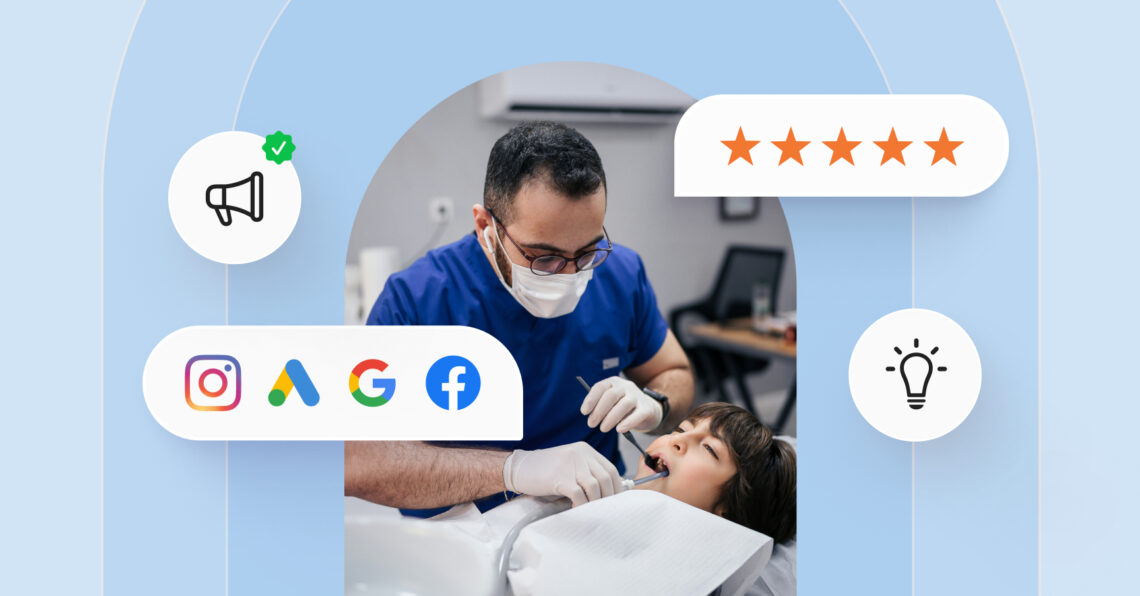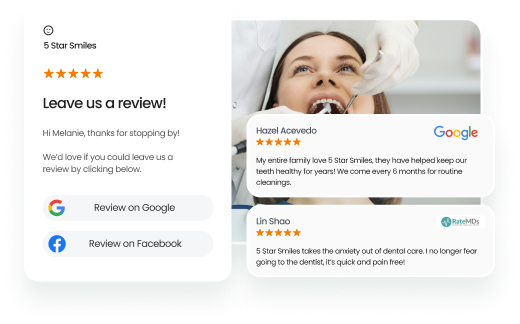Digital marketing for dentists plays a crucial role in how patients discover, evaluate, and choose their dental care providers. Most people begin their search online, often relying on reviews, ratings, and your online presence to guide their decisions.
Did you know that over 90% of healthcare reviews appear on Google, where 65% of local business searches begin (Birdeye Study). For dentists, this means most patients are forming their first impressions of your clinic long before they ever walk through your doors.
A strong digital marketing presence helps your dental clinic establish trust and influence patient decisions before the first call or appointment request. Patients now expect straightforward appointment options, clear service information, and prompt responses to their questions. Meeting (and exceeding) these expectations can be the difference between winning a new lifelong patient or losing them to a competitor.
This blog outlines practical digital marketing strategies tailored for dental practices in 2025. You will also find valuable tools, practical techniques, and common mistakes to avoid to grow your practice sustainably.
Table of contents
- What is digital marketing for dentists and why does it matter?
- Digital marketing for dentists: Top strategies your practice must adopt
- Common digital marketing mistakes dental clinics should avoid
- Ethical and legal guidelines for dental marketing
- How South Georgia Dental scaled its digital marketing across 88 locations
- Final thoughts
- Frequently asked questions on digital marketing for dentists
- How Birdeye supports digital marketing for dentists
What is digital marketing for dentists and why does it matter?
Digital marketing for dentists is the use of online channels, such as search engines, social media, paid ads, content marketing, and email, to promote a dental practice, attract new patients, and maintain relationships with existing ones.
It involves strategies like dental SEO, online reputation management, mobile-friendly websites, and automated communication to ensure patients can easily find, trust, and choose your services.
Why it matters:
- Improves local visibility: Dental SEO and a complete Google Business Profile help your practice appear in “near me” searches for services like implants, teeth whitening, or emergency care.
- Targets patients with specific needs: Paid ads and social media can reach the exact audience you want, from parents needing pediatric care to adults seeking cosmetic treatments.
- Builds trust before the first visit: Educational content, treatment explainers, and staff introduction videos make patients feel informed and comfortable.
- Ensures a seamless mobile experience: A mobile-optimized website makes booking and browsing effortless, boosting satisfaction and conversions.
- Saves time and budget: Tracking tools like Google Analytics (GA4) reveal which marketing efforts drive calls, forms, and bookings, so you invest in what works.
- Enables easy appointment booking: Online scheduling from your website or Google Business Profile lets patients book 24/7 without calling.
- Keeps patients engaged between visits: Automated reminders, newsletters, and follow-ups maintain relationships and reduce no-shows.
- Streamlines communication: A dental CRM centralizes patient messaging, reviews, and follow-ups for better organization and efficiency.
- Maintains compliance: HIPAA-compliant platforms protect patient data and ensure secure communication.
Digital marketing for dentists: Top strategies your practice must adopt
A robust dental digital marketing strategy boosts discoverability, captures demand from local searches, and drives long-term growth. This helps your practice grow sustainably, cut marketing waste, and create a better experience for both new and returning patients.
1. Local SEO for dental clinics
- Optimize your website for search queries like pediatric dentist in New York or root canal specialist near me.
- Set up local schema markup and ensure NAP consistency across directories.
- Create geo-targeted content with keywords relevant to your service area.
2. Google Business Profile optimization
- Keep your profile updated with accurate hours, services, categories, and photos.
- Post regularly using Google updates and add FAQs for patient queries.
- Monitor and respond to reviews promptly.
3. Paid advertising using Google Ads and LSAs
- Run Google Ads for high-intent searches like same-day dental crown.
- Try Local Service Ads (LSAs) for emergency or urgent dental care.
- A/B test ad creatives and landing pages to increase click-through and conversion rates.
4. Social media marketing for dental practices
- Share before-and-after photos (with consent).
- Create engaging reels on oral hygiene tips or quick clinic tours.
- Partner with local micro-influencers or wellness experts for authentic reach.
- Run co-branded giveaways with local businesses.
- Use trending TikTok audio formats for dental tips or staff intros.
- Build community by creating private Facebook groups or sharing behind-the-scenes clinic moments.
5. Content marketing
- Create educational blog posts like 5 signs you need a root canal or Invisalign vs braces.
- Address frequently asked questions to improve search rankings.
- Use visual content like infographics or carousel posts.
- Expand into podcasting or audio content to educate patients on oral health, new technologies, or expert tips in a more convenient format.
6. Video marketing
- Post patient testimonials and procedure explainers
- Host live Q&A sessions for engagement.
- Improve discoverability by adding closed captions, video transcripts, location tags, and schema markup.
- Use YouTube chapters for longer videos to aid navigation and repurpose clips for TikTok, Reels, and Shorts.
Pro tip: For better Video SEO, add location tags to your YouTube videos, include relevant dental keywords in titles and descriptions, and embed videos on key service pages to increase search visibility and engagement.
7. Multilingual marketing
- Offer website content, ads, and email campaigns in multiple languages, especially if your clinic serves a diverse community.
- Add language toggles to your website.
- Create location-specific ads tailored to cultural or language preferences.
- Mention localized ad creatives, not just translated text, but cultural adaptation.
8. Online referral campaigns
- Encourage current patients to refer friends by offering small rewards (e.g., discounted cleanings or gift cards).
- Use digital tools to automate tracking and referral submissions.
- Promote referral programs via email, SMS, and on your website.
Pro tip: Use Birdeye Referrals to automate patient referral campaigns, track submissions, and send timely follow-ups, helping you grow your practice through word-of-mouth at scale.
9. Voice search optimization
- Adapt website content to natural questions like Who is the best dentist for kids in [city]?
- Add conversational keywords and FAQ sections for better voice search results
10. Review generation and reputation management
- Request reviews via SMS or email immediately after appointments.
- Highlight top reviews on your website and social media.
- Respond with personalized replies to build trust and local SEO.
- Use AI to personalize review responses at scale and detect feedback patterns.
- Prepare a crisis communication plan to handle negative feedback quickly and professionally.
- Encourage patient-generated content, such as before/after photos or personal testimonials, to strengthen authenticity.
11. Email and SMS communication
- Set up email campaigns for appointment reminders, birthday greetings, and dental hygiene tips.
- Use SMS for recall reminders and last-minute openings.
- Segment your contact list based on patient type or service history.
- Use patient history to send tailored content like post-treatment tips, recall reminders, or service-specific discounts.
12. Automated communication tools
- Use AI-powered chatbots to assist with 24/7 appointment booking, FAQs, and post-treatment guidance, even outside business hours
- Enable live chat on your website to engage website visitors in real time and reduce drop-offs.
- Route incoming leads from chat to the front desk or CRM based on inquiry type or urgency.
- Automate scheduling and reminders to minimize no-shows.
Note: Tools like Birdeye Chatbot AI manage bookings, answer questions, and capture leads, keeping your practice responsive 24/7.
13. Patient engagement technology
- Use interactive tools like quizzes, symptom checkers, or treatment finders to educate patients and keep them engaged.
- Offer patient portals for accessing appointment history, prescriptions, billing, and treatment plans conveniently.
- Integrate your CRM to personalize communication based on patient behavior, service history, and preferences.
14. Patient experience surveys and sentiment analysis
- Use post-visit surveys (CSAT, NPS) to collect feedback.
- Identify trends in patient experience and address service gaps.
- Use AI tools to summarize sentiment across all reviews and feedback channels.
Pro tip: Utilize Birdeye Insights AI to automatically analyze patient feedback across reviews and surveys, allowing you to identify recurring issues and optimize operations across all locations.
15. Website optimization and user experience improvement
- Optimize for speed with compressed images, clean code, and fast hosting.
- Ensure mobile-first design with responsive layouts that adapt to all devices.
- Simplify navigation with clear CTAs like Book Now or Request Consultation.
- Embed live chat, online forms, and interactive maps.
- Meet ADA compliance standards:
- Use alt text for images
- Support keyboard navigation
- Maintain proper color contrast
- Offer downloadable forms in accessible formats
- Support screen reader support for patients with visual impairments.
Note: Use structured data (schema markup) to help search engines understand your content and display rich results, especially for videos, services, and reviews.
16. Standard SEO techniques
- Target high-intent keywords like family dentistry, dental veneers, or kids dentist near me.
- Create pillar content that links to related service pages for improved topical authority.
- Optimize page titles, meta descriptions, and header tags.
- Build backlinks from local healthcare directories and partners.
17. HIPAA-compliant retargeting & Privacy Practices
- Use privacy-safe retargeting platforms to re-engage website visitors without compromising patient data.
- Serve tailored ads based on viewed services (e.g., teeth whitening, implants), ensuring consent is obtained.
- Offer exclusive incentives like new patient discounts to encourage bookings.
- Always obtain patient consent before sharing photos or reviews.
- Educate staff on handling PHI in DMs, emails, and online responses.
- Comply with both federal HIPAA rules and any state-specific regulations for patient communication.
18. Listing and directory management
- Keep your listings updated on Google, Bing, Apple Maps, and dental directories like Zocdoc, CareDash, and Healthgrades.
- Use automated tools that sync hours, phone numbers, and services across all platforms.
Tip: Birdeye Listings AI Agents automatically update and sync your practice details across top directories, helping boost local SEO and maintain accurate information everywhere patients search.
Combining these strategies provides a structured approach for dental practices to target the right patients, deliver timely information, and create an experience that builds trust over time. A thoughtful digital marketing approach for dentists’ dental practices not only attracts new patients but also develops long-term relationships that support practice growth.
Common digital marketing mistakes dental clinics should avoid
Even successful dental practices can lose ground online when basic marketing errors go unaddressed. These mistakes often hinder visibility, erode credibility, and restrict the flow of new patients.
Here are some of the most common issues to be aware of.
1. Inconsistent business information
Your clinic’s name, address, and phone number (NAP) must match exactly across all directories. Variations in listings confuse search engines and lower your ranking in local results. Patients may also hesitate if they see conflicting details online.
2. Ignoring or responding poorly to reviews
Reviews influence how potential patients view your dental practice. Ignoring feedback or using one-size-fits-all responses can seem careless. Personalized, timely replies show that your team is attentive and values patient input.
3. Over-reliance on a single marketing platform
Running only Facebook ads or only updating your Google profile narrows your reach. Different platforms serve different patient demographics. Using a mix of channels helps you connect with both new and returning patients.
4. Outdated or poorly designed website
An outdated or clunky website can quickly deter visitors. Patients expect mobile-friendly pages, precise service details, and easy access to appointment booking. Your website should reflect the professionalism of your clinic.
5. Not tracking marketing results
Without measuring results, it’s hard to know what’s working. Many dental clinics skip this step and continue with ineffective campaigns. Use analytics to monitor calls, clicks, form submissions, and patient inquiries to make informed decisions.
6. Lack of fresh and useful content
When your blog or website fails to provide helpful information, it limits your visibility and the potential to establish credibility. Posting answers to common questions or creating treatment guides helps inform patients and improves your SEO.
Proven Digital Marketing for Dentists Strategies
Want to see the impact of Birdeye on your business? Watch the Free Demo Now.
7. Inconsistent brand messaging
Your social media, emails, and website should all reflect the same voice, tone, and visual style. Inconsistencies in design or language can confuse potential patients. A clear, recognizable brand creates a more professional impression.
8. Focusing only on new patients
Some clinics invest heavily in attracting new patients but forget about retention. Staying in touch with current patients through recall messages, newsletters, or birthday greetings encourages repeat visits and referrals.
9. Weak local SEO strategy
Failing to optimize for searches like “dentist near me” or “emergency dental care in New York” can make your practice harder to find. Local keywords, complete listings, and positive reviews help improve visibility in nearby searches.
10. Poor mobile experience
If your website is difficult to view or use on a phone, patients may leave without taking action. Ensure your site is responsive, loads quickly, and allows users to call, message, or book appointments easily on mobile devices.
Avoiding these mistakes can strengthen your online presence and help your clinic attract and retain more patients. Focus on consistency, clarity, and patient-first communication across every digital channel to build long-term success using reliable digital marketing strategies for dentists.
Ethical and legal guidelines for dental marketing
Effective digital marketing is not just about strategy; it also requires ethical responsibility and legal compliance. Dentists must protect patient privacy, communicate transparently, and follow regulations that ensure trust and professionalism.
Below are the key ethical and legal considerations to keep in mind.
Ethical responsibilities
1. Honest representation of services
All promotional content should accurately describe the dental services offered. Overstating results or using exaggerated language can mislead potential patients and damage the credibility of the healthcare provider.
2. Patient privacy and consent
Using patient testimonials, before-and-after photos, or health information requires written consent. Digital marketing must never compromise confidentiality, especially under HIPAA rules.
3. Clear separation between ads and content
Sponsored messages or promotions should be clearly labeled. Patients need to understand the difference between marketing content and educational information or practice updates.
4. Avoiding unrealistic promises
Advertising should never imply guaranteed results or unusual outcomes unless supported by clinical evidence. Promises that sound too good to be true can lead to patient distrust.
5. Following professional dental guidelines
Refer to ethical codes and recommendations from dental associations. These help ensure your marketing remains aligned with professional standards of care and conduct.
Legal obligations
1. HIPAA-compliant communications
Email campaigns, online forms, chat tools, and review replies must be designed to protect patient health data. Any breach could lead to serious legal consequences.
2. Adherence to federal advertising rules
The Federal Trade Commission (FTC) requires accuracy in advertising, particularly for health claims. Hence, testimonials, discounts, and endorsements must follow FTC guidelines.
3. State-level dental board regulations
Each state may have specific advertising laws for dentists. These can include rules about using credentials, showing patient images, or claiming specialty services.
By staying transparent, accurate, and respectful of privacy, dental professionals can market effectively without compromising their ethical or legal obligations.
How South Georgia Dental scaled its digital marketing across 88 locations
South Georgia Dental sought a more structured and efficient approach to managing digital marketing across its expanding network of 88 dental practices. With limited time and resources at the local office level, they needed a solution that allowed them to coordinate marketing centrally while still tailoring content for each location. That’s where Birdeye came in.
Problem: Inconsistent content and scattered workflows
Before Birdeye, each office handled its social media. Posts were inconsistent, patient engagement was low, and the marketing team had no visibility into what was being shared. Coordinating campaigns across dozens of locations was time-consuming and prone to errors.
Solution: A centralized, scalable social media system
Using Birdeye Social AI, South Georgia Dental now manages all its social media accounts from a single dashboard. The marketing team can:
- Schedule and publish content for all practices at once.
- Use dynamic tokens to personalize posts with office names, addresses, or contact info.
- View and manage all upcoming posts in one shared calendar.
- Create engagement-focused content like holiday messages, promotions, and patient education.
Results: More engagement with less effort
By unifying their digital marketing operations:
- They added 1,300 new followers across platforms
- Maintained brand consistency across 88 locations
- Eliminated manual posting by local staff
- Increased awareness and engagement without increasing headcount
This case demonstrates how dental groups can scale digital marketing by streamlining workflows and planning content effectively. Tools like Birdeye Social make it easier to maintain quality, consistency, and local relevance from a single platform.
Note: Multi-location dental groups need tools that support centralized control while allowing local personalization. Birdeye’s all-in-one platform focus on consistent branding, accurate listings for each location, and scalable social media workflows to maintain relevance across all markets.
Final thoughts
A well-executed dental digital marketing strategy is essential to attract, engage, and retain patients. From local SEO and social media to website optimization and review management, each component works together to shape how patients discover and evaluate your services.
As patient expectations continue to shift online, investing in digital marketing helps practices remain prominent, communicate effectively, and establish long-term credibility. Whether you are just starting or refining an existing approach, a consistent and thoughtful strategy can support both patient satisfaction and sustainable growth.
Frequently asked questions on digital marketing for dentists
Digital marketing enables dentists to enhance their online presence, foster trust, and attract patients through targeted search, positive reviews, and effective social media strategies.
Local SEO and an optimized Google Business Profile are particularly effective for reaching people actively searching for dental services in their area.
Reviews shape first impressions and help patients feel confident in choosing a dental provider.
Yes, engaging social content and local campaigns can increase awareness and encourage patients to contact your practice.
Key elements include mobile responsiveness, fast loading, straightforward navigation, online booking, and helpful patient information.
Yes, it allows focused outreach, measurable results, and flexibility to adjust campaigns based on performance and budget.
How Birdeye supports digital marketing for dentists
Birdeye helps dental practices attract more patients, enhance online recognition, and maintain a strong reputation. Its AI-powered tools simplify how clinics manage reviews, communication, listings, and patient engagement across every stage of the care journey.
Let’s take a look at how Birdeye supports digital marketing for dentists:
1. Reviews AI
Birdeye connects with dental CRMs to automatically request reviews from patients after appointments. It uses AI to write personalized, on-brand responses. This helps your dental practice build trust, respond quickly, and improve positioning on platforms like Google, where most healthcare reviews are posted.
2. Listings AI
Birdeye updates your name, address, and phone number across directories to ensure your information is consistent and improves local SEO.
3. Messaging AI
Patients often contact dental clinics through text messaging, web chat, and social media platforms. Birdeye brings all those messages into a single inbox. AI-assisted replies enable your front desk to respond quickly, enhancing appointment booking and minimizing delays.
4. Chatbot AI
Birdeye’s AI chatbot answers common questions, collects lead information, and schedules appointments directly through your website. It helps convert website visitors into patients without adding to your team’s workload.
5. Social AI
Birdeye enables you to schedule content across Facebook, Instagram, and other social platforms. It also suggests captions and content ideas tailored to dental topics, such as oral hygiene tips or treatment highlights.
6. Referrals
Birdeye automates referral programs, allowing you to reward patients for referring friends or family. Campaigns can be shared via email or SMS, and all activity is tracked in one centralized location.
7. Insights AI
Birdeye analyzes reviews and surveys to identify trends, such as long wait times or positive feedback about the services. This insight helps you make improvements that matter to your patients.
Birdeye brings together all the essential tools for digital marketing in dentistry. From review generation to social posting and patient communication, it helps your dental practice grow efficiently and stay connected with your community.

Originally published









